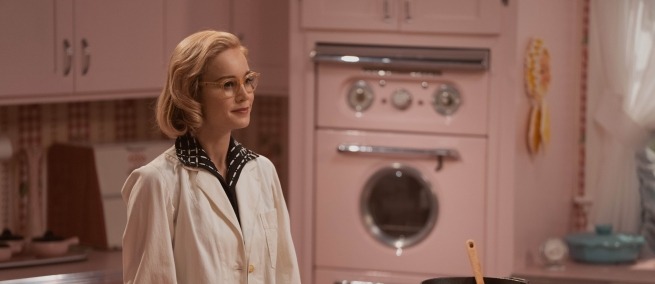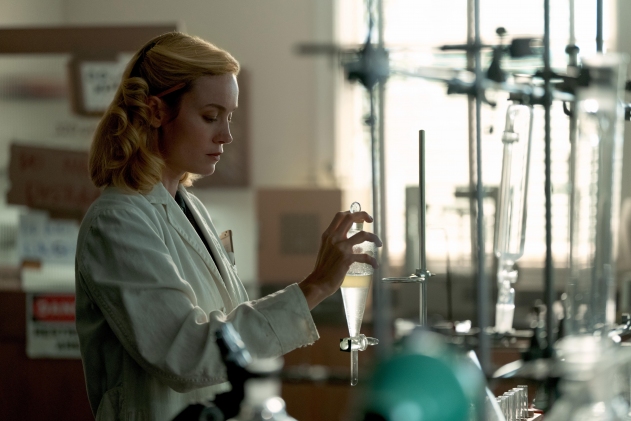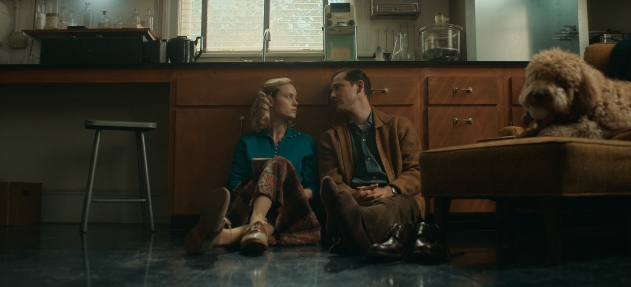
LESSONS IN CHEMISTRY is the new eight-episode miniseries on Apple TV+ that stars Brie Larson as Elizabeth Zott, a chemist in 1950s America whose career is stymied by societal expectations of women, but who finds a niche applying chemistry to food and becomes a television sensation with her own cooking show. The series was developed by Lee Eisenberg based on a novel by Bonnie Garmus. In addition to Brie Larson, the show stars Aja Naomi King, Stephanie Koenig, and Patrick Walker. To get the science right, the show employed a chemistry advisor, Jessica Parr, who is a Professor of Chemistry at the Univesrity of Southern California. We spoke with Professor Parr about her work on the show, its depiction of women in science, and how she wanted the show's depiction of chemistry to be distinctive.
Science & Film: Could you tell me a bit about your background and how you got involved in this television show?
Jessica Parr: I have always been interested in science. I decided to major in chemistry when I was in college, and I had no idea what I wanted to do with it, so I went to graduate school to get my PhD in chemistry, out here at the University of Southern California. I realized pretty early on that I liked instruction. ]I have been teaching faculty here at University of Southern California since 2007, which means, basically, I teach five very large enrollment classes every year, and others where they need me. Over the years, I've mentored students from other departments through our Women in Science & Engineering program. One of those students, her advisor's partner was one of the producers on the show. They were looking for a chemistry consultant, because it's a large part of Elizabeth's identity, not only in the book, but they wanted to make it a big part of the show as well. So, they wanted to make sure the science was as correct to science as it should be. Tracey [Nyberg] got in touch with me and I said it sounded like an interesting thing to do, and that's how I got involved.
S&F: In what ways were you involved with the production?
JP: I was involved in the scripts that actually had science in them. Of the eight episodes, four them were pretty heavy on science. Some others focused on other parts of Elizabeth's life or more on the food science side, which is not what I am super familiar with, although I do plenty of cooking. I did read through the scripts, I worked with props a lot before shooting began. I did a little bit of work with Brie [Larson] and Lewis [Pullman] to show them how to do some science, things that a chemist would do during the 1950s so that they could get used to the actions before shooting began. The props department I was working with on the show had just finished doing THE DROPOUT, which was also very science heavy. They didn't want to shoot without a science expert on set for the days that actually involves scenes in the lab, or there were a couple of scenes from Elizabeth's house where she's trying to do some of her chemistry at home. I got to see lots of different parts from pre-production all the way through the actual shooting. I also talked a little bit with some of the graphics designers who are going to do some things in post-production.

Brie Larson in LESSONS IN CHEMISTRY, courtesy of Apple TV+.
S&F: How is the depiction of a chemistry lab in LESSONS IN CHEMISTRY, set in the 1950s, different than what a lab might look like today?
JP: Honestly, as far as the glassware goes, it is pretty much all the same. So the beakers, round bottom flasks, you'll see them using Erlenmeyers, all of those are--I don't know historically how long they've been used--but they were definitely in use in the 50s and are still used today. The main things that have probably changed are some of the instruments have become more sophisticated. Some of the things that they would have done with a machine, those machines have gotten smaller, just like our computers have gotten smaller. But the labs, we even have some here on campus that were probably built about the same time, and the cabinets look very similar, and the benches look very similar. Now, just like you'd update your kitchen with new cabinets, you would update your lab with slightly nicer looking cabinets. But I think the main difference, and one thing I actually didn't insist on, but mentioned that they did incorporate a little bit into the show is now we have a lot of people who watch out for safety and other things. You're not allowed to eat in the lab, there's no smoking in the lab, there's mainly no smoking in any building anymore. But in the 50s, there were a lot of people who had their lunch while they were running experiments. You'd usually walk in and the lab would just be filled with cigarette smoke, because everybody was smoking at the time, even around very flammable things. The main difference I think is that we're more safety conscious now than we were.
S&F: In terms of the show's depiction of a woman in science and the barriers that Elizabeth faces, in your own work and experience in the field, how does this depiction resonate with you? How present do you feel these same issues still are?
JP: I can't say that I necessarily experienced a lot of discrimination myself, because of my gender. I was very lucky. I went to Goucher College for my undergraduate experience, which is a very small liberal arts school, just north of Baltimore, that until about 1985 had been all female. When I was there in the late 90s, early 2000s, it was still 70% female, so it wasn't unusual to have women interested in science. And they had a very strong program. Then I came here, and I ended up working for a female advisor. I surrounded myself with a very supportive environment. It may have been different if I'd gone to a different institution. But I do know a lot of colleagues, particularly in engineering now, who have still experienced a lot of that discrimination or expectations for what you're going to be able to do and not do just based off of gender alone. I think that it is a very realistic depiction of what her [Elizabeth's] experience would have been had she had that role as a lab tech. I think she would have definitely been the lone woman in the room for much of it, having to deal with all of the comments, which, unfortunately, all of us as women experience at some point somewhere, no matter what your role is. I think that we've made a lot of progress over the years, and I think that that's not only due to pioneering women who are similar to Elizabeth, but also to our allies on the men's side who have helped take down some of the barriers and then also lift up women along the way.

Brie Larson and Lewis Pullman in LESSONS IN CHEMISTRY, courtesy of Apple TV+.
S&F: Is there anything about the science and experiments that they're doing in the show, the questions they're asking, that are still significant in the field?
JP: I think it's still relevant to what's happening now and is kind of pioneering along the lines of understanding how DNA works, I think that we have a much better idea of that now based off of some of these experiments similar to what they were doing. But, one thing for me that was important, and one reason why I said yes to the roll, was I wanted to make sure what was being depicted on screen was realistic to what someone would actually see in the laboratory, not only from the prop side, but also a lot of times, you see these science depictions from the 70s, 80s, or B-movies where there are all these beautiful colors, and everything's bubbling over and looks fantastic, visually. But in reality, if you got that many colors and things bubbling over, you probably did your experiment wrong. So, I wanted to make that the way we were depicting things, which may not be as interesting or as brightly colored, wouldn't take someone who understands chemistry or biochemistry out of the story, because they got distracted by the visuals not lining up with what they expected. I really did appreciate the directors and set dressing and everyone not pushing—they also wanted it to be a true depiction of what would have been experienced at the time.
♦
TOPICS